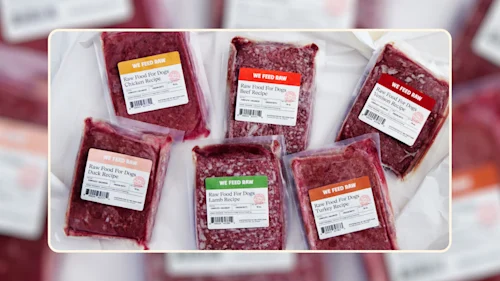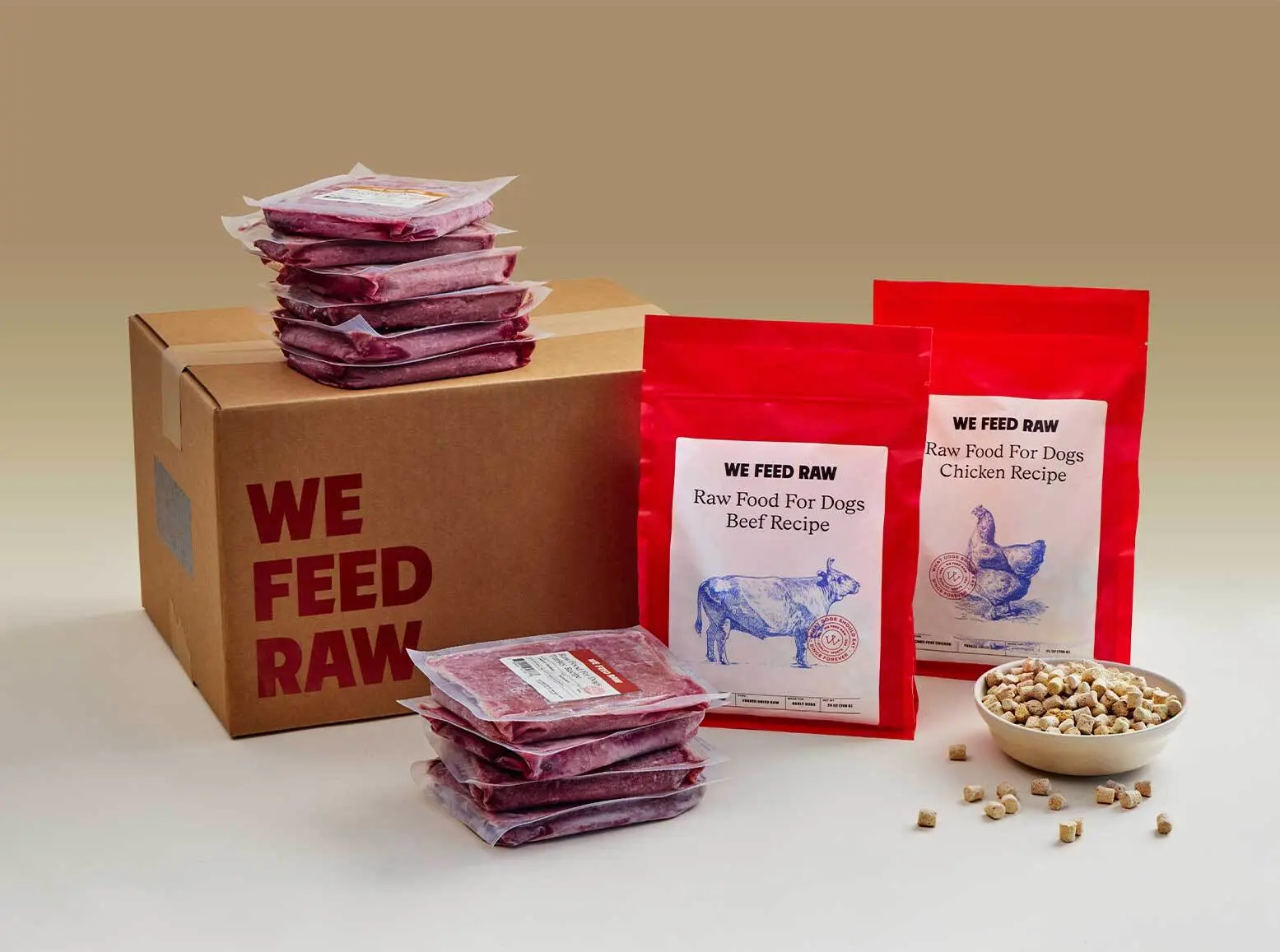
How to Feed Raw Dog Food: A Beginner's Guide
Table of Contents
- Benefits of Feeding Raw Food to Dogs
- Incorporating Raw Foods into Your Dog’s Diet
- Types of Raw Pet Food Options
- Transitioning to Raw Foods
- Practical Tips for Feeding Raw Food to Dogs
- Special Considerations in Feeding Raw Food to Dogs
- Choose We Feed Raw for Convenience and Quality
- Frequently Asked Questions (FAQs)
Curious about how to feed raw dog food, but feeling overwhelmed by all the information out there? You're not alone. Feeding raw can seem daunting at first, with questions about portion sizes, balancing nutrients, and ensuring your pup gets everything they need.
We Feed Raw is here to make the raw feeding transition smooth and satisfying for both you and your canine companion. We understand that every dog is unique, and their dietary needs can vary.
However, there's no denying the multitude of benefits raw dog food offers. From shinier coats and more energy to improved digestion and overall well-being, raw food can truly transform your dog's health. In this guide, we'll break down the simple steps of feeding raw dog food with We Feed Raw, making it easy for you to unlock the natural power of raw nutrition for your furry friend.
Benefits of Feeding Raw Food to Dogs
Feeding your dog a raw diet can offer a multitude of health benefits. Here are some of the key advantages:
•Improved Digestion: Raw food mimics a dog's natural diet, leading to better digestion.
•Enhanced Nutrient Absorption: Raw food contains enzymes that aid in digestion, allowing your dog's body to absorb nutrients more efficiently.
•Healthier Skin and Coat: A raw diet can promote a healthier skin and coat, reducing shedding and improving overall appearance.
•Boosted Immune System: The nutrient-rich nature of raw food can help strengthen your dog's immune system, making them more resistant to illness.
•Increased Energy Levels: Raw food provides a natural energy boost, leaving your dog feeling more alert and active.
•Dental Health: The carbohydrates in kibble contribute to dental problems. Naturally low-carb raw dog food contains enzymes that help keep your dog’s teeth clean and gums healthy.
•Reduced Allergies: Raw food can help alleviate allergies and sensitivities by eliminating common allergens found in processed dog foods.
By choosing a raw food diet for your dog, you're providing them with the most natural and nutritious way to thrive.
Understanding Raw Dog Food Portions
Wondering how much raw food you should feed your dog? We Feed Raw makes it easy by shipping you pre-portioned nutritionally complete and balanced patties and telling you how much to feed daily.
If you choose to make your own raw diet, you should feed your dog about 2-2.5% of their ideal body weight each day. However, your dog may need more or less than that depending on their age, activity level, body condition, and various other factors.
Incorporating Raw Foods into Your Dog’s Diet
If you're not quite ready to fully transition to a raw food diet, there are still ways to introduce raw elements into your dog's meals. Consider adding raw, uncooked meat, organs, or bones (or a little bit of We Feed Raw) to their regular kibble or canned food as a topper.
While a fully raw diet is best, we know that’s not an option for everybody. Adding even some raw to your dog’s current diet can offer numerous benefits, so some raw food is always a win for your pup.
Types of Raw Pet Food Options
When it comes to commercial raw dog food diets, there are two main types: frozen raw patties and freeze-dried or dehydrated options. Each has its own pros and cons.
Raw Frozen
Short of letting your dog hunt for their meals, frozen raw is about as close as you can get to what a dog would eat in the wild. Keeping patties frozen helps preserve them for up to six months and retains the maximum amount of moisture.
Frozen raw food for dogs has two main drawbacks: it requires a lot of freezer space, and it isn’t especially convenient, especially if you travel a lot.
Freeze-Dried Raw and Dehydrated Raw
Freeze-dried and dehydrated raw dog food meals are more convenient than frozen raw options since they’re as easy to feed as kibble. However, freeze-drying and dehydrating both remove most of the moisture from the raw food, which reduces some of the benefits of a raw diet.
Transitioning to Raw Foods
While some dogs will do fine with a sudden switch from kibble or another diet to raw food, we recommend taking at least 10 days to gradually transition your dog to a fully raw diet so their digestive system has a chance to get used to the new food.
Raw Diet Transition Schedule
For the first three days, you should feed your dog 75% of their current diet and 25% of their new raw diet. On the fourth day, you can start feeding a 50/50 diet. After a few days feeding 50/50, start feeding your dog 25% of their old food and 75% raw. By the 10th day, you should be able to start feeding a fully raw diet.
Keep in mind that every dog is unique. Some dogs may be able to transition more quickly, while dogs with especially sensitive digestive systems may need a few weeks to make the transition more gradually.
Use your dog’s stool as a guide. If your pup develops digestive problems, slow the transition down until their poop returns to normal.
Practical Tips for Feeding Raw Food to Dogs
Feeding raw food to your dog can be a rewarding experience, but it's important to follow some practical tips to ensure a smooth transition and maintain optimal health:
•Start Slowly: Introduce raw food gradually to allow your dog's digestive system to adjust. Start with small portions and gradually increase the amount over time.
•Choose a Reputable Brand: Opt for a reputable brand of pre-portioned raw dog food to ensure proper nutritional balance and safety.
•Store Raw Food Properly: Store raw food in a freezer to maintain freshness and prevent bacterial growth.
•Thaw Food Safely: Thaw frozen raw food in the refrigerator or using a cold water bath. Avoid thawing at room temperature.
•Monitor Your Dog's Health: Keep an eye on your dog's stool consistency, energy levels, and overall health. If you notice any changes, consult your veterinarian.
By following these tips, you can confidently and safely incorporate raw food into your dog's diet.
Special Considerations in Feeding Raw Food to Dogs
While raw food diets offer numerous benefits, it's important to consider a few key factors. Every dog is unique, and their dietary needs may vary.
Introducing raw food gradually allows your dog's digestive system to adjust smoothly. Proper storage and handling of raw food are crucial to maintaining its freshness and safety.
By following these guidelines, you can confidently and safely incorporate raw food into your dog's diet.
Choose We Feed Raw for Convenience and Quality
It’s incredibly difficult to make a DIY raw food diet for dogs that’s nutritionally complete and balanced, and it certainly isn’t convenient.
We Feed Raw offers fully balanced frozen raw patties that have been through a high-pressure process to inactivate potentially harmful pathogens, making our raw food the safest choice for your pup. We also tell you precisely how much to feed your dog daily and how to transition your dog to our food.
Take our quiz now to get your dog started on a meal plan.
Frequently Asked Questions (FAQs)
What are the guidelines for feeding my dog a raw food diet?
Feeding your dog a raw food diet is straightforward. Choose a reputable brand of pre-portioned raw dog food to ensure proper nutrition. Introduce raw food gradually to allow your dog's digestive system to adjust. Store raw food in a freezer and thaw it safely. Monitor your dog's health and adjust their diet as needed.
What is the appropriate amount of raw food to feed my dog?
The appropriate amount of raw food for your dog depends on several factors, including their age, weight, activity level, and breed.
While We Feed Raw tells you exactly how much of our food to feed your dog based on information you give us about your pup, a general guideline suggests feeding 2-2.5% of your dog's ideal body weight per day.
Is there a standard portion size when feeding raw food to dogs?
While there isn't a one-size-fits-all answer, We Feed Raw provides pre-portioned meals tailored to your dog's specific needs. These portions are carefully calculated to ensure optimal nutrition and avoid overfeeding. Factors like your dog's age, weight, and activity level influence the appropriate portion size.
What benefits can I expect from feeding my dog a raw food diet?
Raw food diets can offer numerous benefits for your dog, including improved digestion, enhanced nutrient absorption, healthier skin and coat, a boosted immune system, increased energy levels, and potential dental health benefits. By choosing a raw food diet, you're providing your dog with a natural and nutritious way to thrive.
Can you advise on how much raw food to feed my dog to maintain health?
To maintain your dog's health with a raw food diet, consider factors like age, weight, and activity level. We Feed Raw offers pre-portioned meals tailored to individual needs.
For general guidance, feeding 2-2.5% of your dog's ideal body weight per day is a good starting point. However, always monitor your dog's weight and adjust their food intake accordingly.
What should I consider when feeding a raw food diet to my dog?
When considering a raw food diet for your dog, it's important to choose a reputable brand like We Feed Raw that offers pre-portioned meals with balanced nutrition.
Introduce raw food gradually to allow your dog's digestive system to adjust, and monitor their health closely. Proper storage and handling are crucial to maintain food safety.
How do I calculate how much raw dog food to feed my pet?
Calculating the exact amount of raw food to feed your dog can be tricky, as it depends on various factors like their age, breed, weight, and activity level. However, a general guideline is to feed around 2-2.5% of their ideal body weight per day.
We Feed Raw takes all the guesswork and calculations out of raw feeding by sending you pre-portioned frozen raw patties on a regular schedule and telling you exactly how much to feed your pup to keep them in optimal health.

Our Meals Change Lives.
(Theirs + Yours.)
See health improvements from our raw meals in as little as 1 week.
